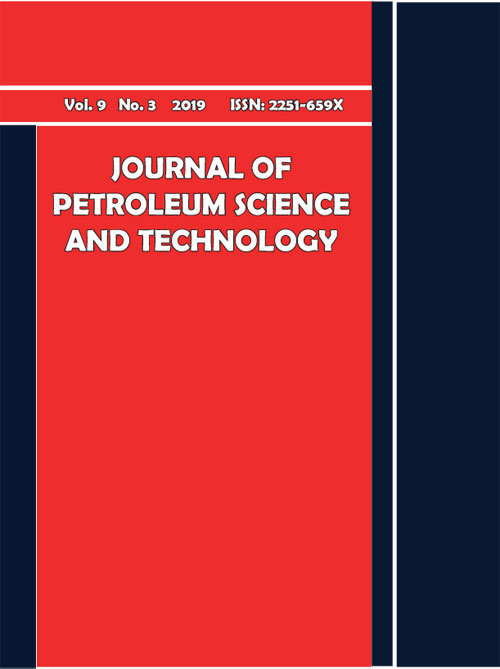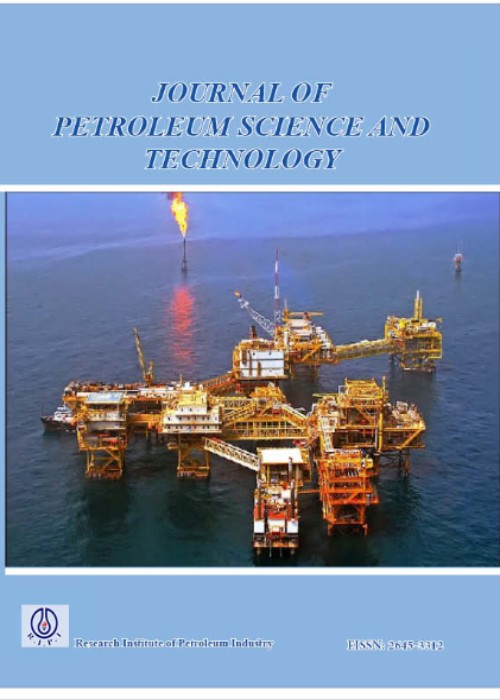فهرست مطالب

Journal of Petroleum Science and Technology
Volume:11 Issue: 2, Spring 2021
- تاریخ انتشار: 1400/10/14
- تعداد عناوین: 6
-
-
Pages 2-12Transformation of ethylbenzene can provide valuable isomers as a raw material for the petrochemical industry. This work explored the transformation of ethylbenzene (EB) over nanozeolite Y with the Si/Al ratio of 5. Fe ion exchange was carried out to modify the acidity of zeolites. The influence of platinum was investigated by the introduction of Pt-Al2O3. XRD, SEM, ICP, BET, FTIR, 27Al MAS NMR, NH3-TPD, and TG tests were applied for the characterization of physicochemical properties of prepared nanocatalysts. The slight decrease in the surface area of synthesized Fe-Y nanocatalysts indicated that the major part of iron was deposited in the catalyst structure. The addition of iron to the nanocatalyst structure resulted in increased strong acid sites and decreased weak acid sites. Reduction in weak acidity led to a lower coke formation rate and higher stability of FeY nanocatalysts. Results illustrated that the intensity of Lewis acidity decreased for all prepared nanocatalysts by increasing the iron content while the number of Bronsted acid sites increased. The addition of platinum-Al2O3 to the FeY nanocatalysts illustrated higher EB conversion and the same catalyst stability as FeY nanocatalysts. Nanozeolite Pt/Fe-Y composed of 0.1 wt.% platinum and 1.0 wt.% iron was obtained to be effective catalyst for EB transformation reaction. The prepared catalyst indicated adequate degree of EB conversion (61%) as well as 77.2% EB isomerization, 3.3% EB disproportionation, 1.4% EB dealkylation, 3.1% EB cracking, 14.8% EB hydrogenation and 0.2% EB transalkylation.Keywords: Nanozeolite Y, Fe ion exchange, EB conversion, Pt impregnation
-
Pages 13-21Formation damage is an unfavorable challenge that occurs during drilling. The present study reports the applicability of aluminum complex (AC, the combination between Al ion of aluminum sulfate (AS) and ethylenediaminetetraacetic (EDTA)) as a permanent clay swelling inhibitor in water-based drilling fluids. That is used to reduce formation damage in the near wellbore. This complex is an environmentally friendly and inexpensive additive in water-based drilling fluids (WBDFs) as a clay swelling inhibitor. In this study, some experiments, including free swelling, bentonite sedimentation, compatibility, and core flood analysis, were performed. The results have shown that AC solution can act properly as a clay swelling inhibitor at an optimal concentration of AC around 5.4 wt.%. Moreover, the compatibility test indicated that the AC additive is compatible with other common additives in WBDF. The results show that adding 8.1 wt.% of AC solution has the lowest permeability reduction compared to other concentrations. Furthermore, core flooding results showed that AC solution can act as a permanent clay inhibitor compared to KCl, a temporary inhibitor. Ultimately, the AC solution performance was not much sensitive to salinity.Keywords: Formation Damage, clay swelling inhibitor, Environmentally Friendly, Aluminum Complex (AC)
-
Pages 22-29
The present study investigated the geochemical characteristics of Shemshak shales as a probable oil source rock in the Gushfil mine located in the Sanandaj-Sirjan Zone (SSZ), Iran. Trace elements such as nickel, vanadium, chrome, molybdenum, and cobalt are used as paleoenvironmental indicators. Moreover, the ratio of these elements shows that oxic to disoxic conditions prevailed during the sedimentation period. The interrelation of these elements indicates that the upper part of Shemshak Formation of the Jurassic age was deposited in a terrestrial to the marine-terrestrial influenced environment. The solid bitumen reflectance (BR) documents that the black shales presently are overmature. Conjugation of BR and the insolubility of organic matter in carbon disulfide illustrates the presence of pyrobitumen and its subgroup epi- to meso-impsonite, which is also characterized by the absence of any fluorescence under ultraviolet light. The ratio of light to heavy hydrocarbons proves that the type of solid bitumen before pyro-bituminization has been a primary-oil solid bitumen, which could migrate through fractures and coarse pores. The primary-oil solid bitumen might be derived from Kerogen types II and III as documented by fibrous plant fragments, translucent phytoclasts and pollens. Presently, due to intense degradation, kerogen type IV dominates. The modeling confirms that a thermal degradation had probably occurred after the deposition of Lower Cretaceous carbonates when the shales were able to produce bitumen. Ultimately, intense hydrothermal degradation led the solid bitumen to evolve into pyrobitumen and caused the shales to evolve into a dry gas window.
Keywords: Shemshak Formation, Pyrobitumen, Trace elements, Dry gas, Thermal Modeling -
Pages 30-42
Basic waxes resulting from all oil refineries such as Paraffin wax and Microcrystalline wax are to be blended using additives to tailor the wax compound’s specifications. Such compounded waxes are suitable to be used in packing, food, labeling, adhesives, and other industrial applications depending on the ratios of paraffin wax (PW) to microcrystalline wax (MCW), in addition to some specific additives affecting the physical, mechanical and thermal properties of the melt. Ethylene Vinyl Acetate (EVA) copolymer is used as a viscosity modifier and tackifing agent, poly hydrogenated dicyclo-pentadiene (HD), and poly alpha-methyl styrene (MS) are wax performing agents based on the desired molecular weight and crystallinity of the wax blends. Different ratios of the polymeric additives were blended with both the basic paraffin and microcrystalline wax. The resulting compounded wax samples were evaluated for their melting behavior: congealing point (CP) and softening point (SP). The drop melting point (DMP) and dynamic viscosities, as well as the hardness, represented as low penetration value) are also investigated. The mechanical properties of the resulting compounded waxes (tensile elongation at break) and the adhesion characteristics are related to the additives composition and percent. All the obtained results showed a complete investigation of all physical, mechanical, and thermal characteristics of the resulted wax blends as a function of their ingredients that were combined with high compatibility within the wax blends. Both the resins, i.e. poly hydrogenated dicyclopentadiene (HD) and poly alpha-methyl styrene (MS) are wax performing agents based on the desired molecular weight and crystallinity of the wax created promising physical, mechanical, and technological properties in all the compounded wax samples.
Keywords: Compounded wax (CW), Paraffin Wax (PW), Microcrystalline waxes (MCW), Paraffin (PN), Dynamic Viscosity (DV), Tensile Strength at Break (TS) -
Pages 43-52Investigating depositional and diagenetic factors that control pore systems properties of reservoir rocks is essential for unraveling reservoir heterogeneity and interpreting reservoir rock types. In this respect, utilization of petrophysical well logs provides enormous information about reservoir properties, which can be interpreted continuously throughout the reservoir interval. In this study, the velocity deviation log derived from the Wyllie time-average equation has been used to differentiate reservoir rock types of the Oligo-Miocene Asmari Formation with a mixed siliciclastic-carbonate lithology from the field in the southwestern of Iran. As a result, four rock types were identified and interpreted throughout the reservoir interval. Each carbonate rock type with certain pore types and reservoir property signifies a specific diagenetic facies. Variation from a siliciclastic (sandstone-shale) environment in lower parts of the reservoir interval to a carbonate system in upper parts, as well as a transition interval (interlayers of carbonate and clastic facies) between them, shows a high degree of reservoir heterogeneity. This could be described by different zones and interpreted in the framework of sequence stratigraphy. The results indicated that the carbonates due to the complex pore systems have the main control on vertical reservoir heterogeneity, reflected by wide variations in velocity deviation. However, the sandstones control the horizontal reservoir heterogeneity through the variability in thickness and lateral continuity of reservoir zones. The findings of this research can be correlated with dynamic reservoir data for the identification and investigation of production zones in the field.Keywords: Reservoir heterogeneity, Pore system, Diagenesis, Reservoir rock types, Velocity Deviation Log
-
Pages 53-62
In most carbonate reservoirs, the amount of oil recycled depends on the spontaneous uptake of brine in the matrix and oil extraction in that matrix towards the cracks. The injection of modified water makes this process possible by changing the wettability of the matrix block towards more water-wet. The rate of wettability change is one of the factors that makes the injection of low-salt water economically. Therefore, this study aims to identify the effect of ion type on the rate of wettability change to modify the composition of the water used for flooding into the reservoir so that the maximum use of this process is to increase oil production from the reservoir. The effect of sodium, magnesium, calcium and sulfate ions on oil recovery from carbonate reservoirs was investigated by a dynamic contact angle test. The results show that increasing the concentration of surfactants such as magnesium, calcium, and sulfate could rise (1) the wettability towards water-wet and (2) the rate of wettability change. In contrast, neutral ions, such as sodium ions, were resulted in a rate reduction in which surface ions change to wettability. Elimination of sodium ions would result in approximately the same amount of change in wettability but in a lesser time from 24 to 2 hrs. The results of the secondary injection showed that although the presence of sodium did not have a significant negative effect on oil recovery, the removal of sodium ions significantly could be improved the sweep efficiency of oil. In modified water, the sodium ion from +0.1 mol to +0.001 magnesium sulfate solution was eliminated. Instead, +0.1 mol sodium sulfate was added to enhance the breakthrough time from 0.31 to 0.43 seconds for injected pore volume. So, the second enhcanced recovery was increased in compare to first EOR.
Keywords: Enhanced Oil Recovery, Wettability, Modified water, Contact Angle, Core Flooding test


